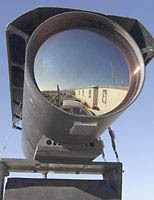Border Cameras: Take Two
September 9, 2009
Gov. Rick Perry gave Texas border sheriffs another $2 million for a virtual border wall of web cameras that in its first full year failed to meet nearly every law enforcement goal his office originally set.
Written by Brandi Grissom, Texas Tribune

AUSTIN — Gov. Rick Perry gave Texas border sheriffs another $2 million for a virtual border wall of web cameras that in its first full year failed to meet nearly every law enforcement goal his office originally set.
Last week, Perry's Criminal Justice Division notified the Texas Border Sheriffs Coalition that it had been awarded a second $2 million grant for the Texas Border Watch program. The program allows anyone, anywhere with an Internet connection to view live footage from cameras trained on the Texas-Mexico border.
"The ultimate goal is to deter, prevent and disrupt crime along the border," said Perry spokeswoman Katherine Cesinger.
Perry hatched the idea for the virtual border watch during his 2006 re-election campaign. He promised then to spend $5 million and line the border with hundreds of surveillance cameras.
After several starts and stops and a test of the program that yielded paltry results, Perry last year awarded the border sheriffs $2 million to run the camera project for one year.
Traffic to the camera Web site, www.blueservo.com, was brisk, with some 40 million people logging onto the site and nearly 125,000 signing up as virtual border deputies.
All those Web hits, though, didn't result in much police work.
Internal grant reports showed that with the initial funding, the coalition was expected to install 200 cameras that would generate about 1,200 arrests and 4,500 illegal immigrant referrals to U.S. Border Patrol.
Year-end reports showed that from June 2008 through June 2009, the coalition — which contracted with BlueServo, a small social networking company —installed just 17 cameras that produced 11 arrests and about 300 immigration referrals.
Don Reay, executive director of the coalition, said despite missing its targets, the camera program was worthwhile.
Success or failure, he said, can't be judged based solely on the numbers.
"You have to look at the community impact, what people feel out there and the fact we're not getting as many complaints there to the sheriffs' offices," Reay said.
During the second year of the grant, Reay said, the coalition expects to install more cameras, to move the cameras more often to various locations along the border and to improve response times to reports from Internet viewers.
The border cameras, he said, are not meant to be the solution to crime and illegal immigration problems on the border. They are just one part of Perry's larger strategy.
Since 2005, the state has spent more than $110 million on border security efforts. Much of that was used to pay state troopers and local police and sheriffs overtime to patrol high-crime areas of the border.
"We've never said we are the panacea... with that camera project," Reay said. "It fits into the overall strategy."
But experts on both sides of the immigration issue agreed that results from the first year of the border camera program showed it was unsuccessful. Some lawmakers called the program a waste.
State Sen. Eliot Shapleigh, D-El Paso, said money that has been used on the border cameras would be better spent on hiring more state troopers and boosting intelligence operations.
The border cameras, Shapleigh said, are more about Perry securing his electoral base ahead of a tough primary election fight than they are about providing security on the border.
"Border cameras are a proven waste of time and money," Shapleigh said, "but his immigrant-bashing base loves them, so that's why he funds them."
![]()
![]()
Related Stories
![]()
Fair Use Notice
This site contains copyrighted material the use of which has not always been specifically authorized by the copyright owner. We are making such material available in our efforts to advance understanding of environmental, political, human rights, economic, democracy, scientific, and social justice issues, etc. We believe this constitutes a "fair use" of any such copyrighted material as provided for in section 107 of the US Copyright Law. In accordance with Title 17 U.S.C. Section 107, the material on this site is distributed without profit to those who have expressed a prior interest in receiving the included information for research and educational purposes. For more information go to: http://www.law.cornell.edu/uscode/17/107.shtml. If you wish to use copyrighted material from this site for purposes of your own that go beyond "fair use", you must obtain permission from the copyright owner.